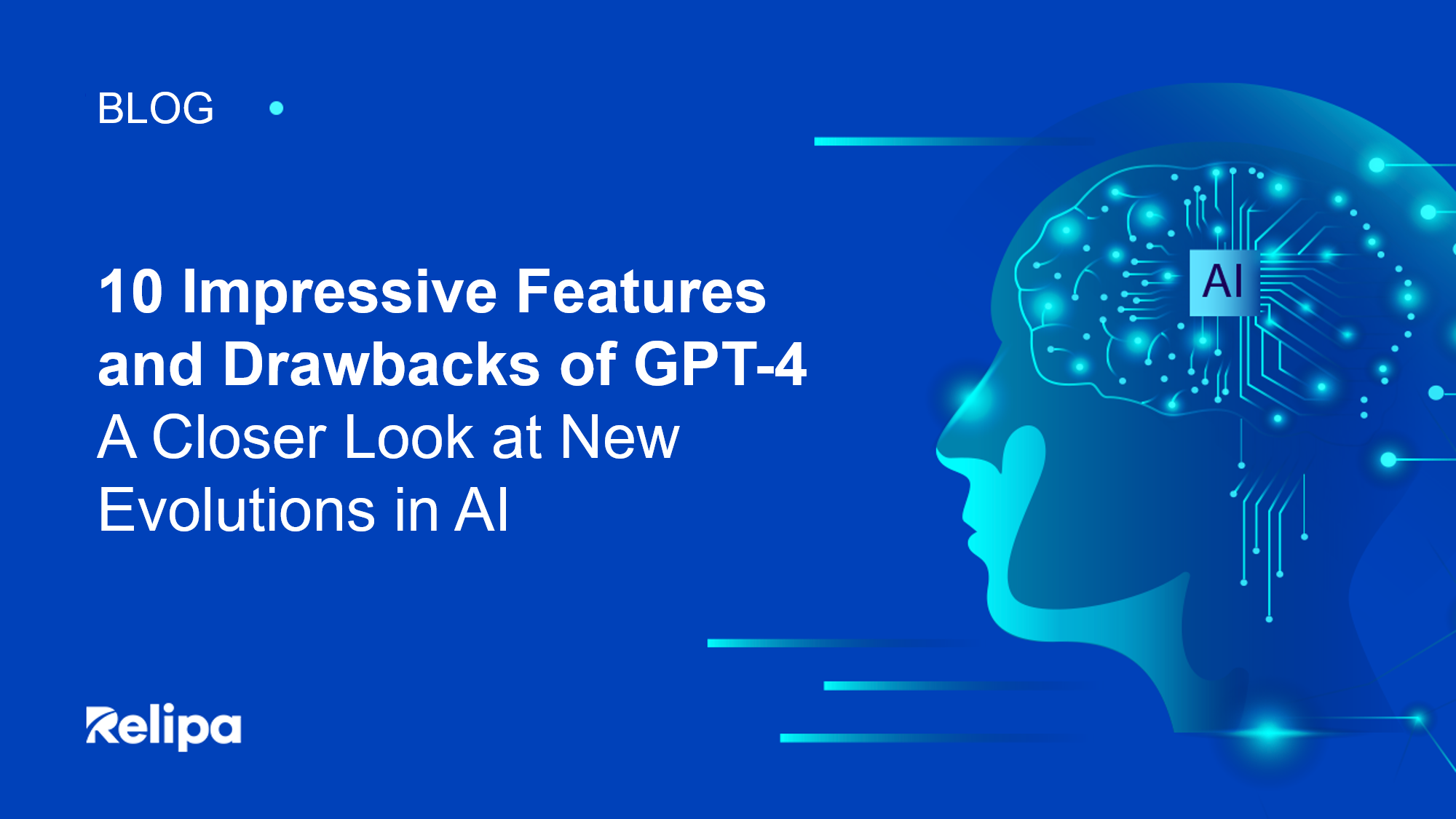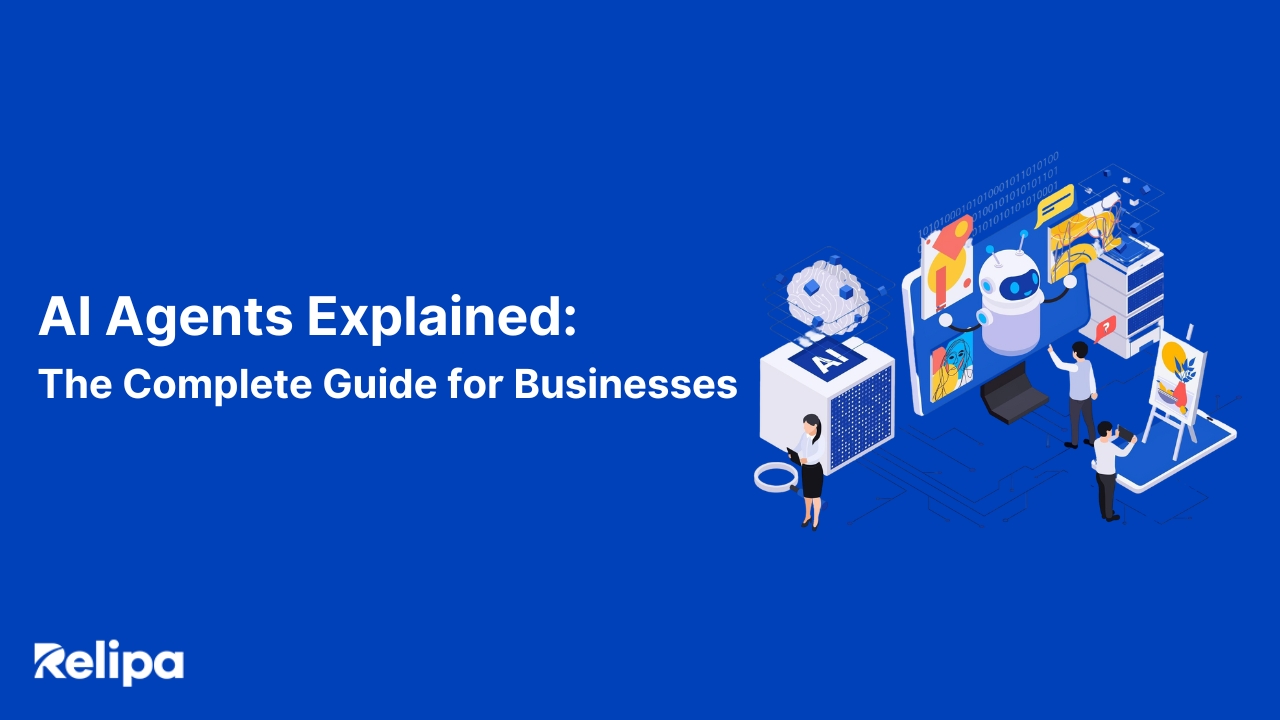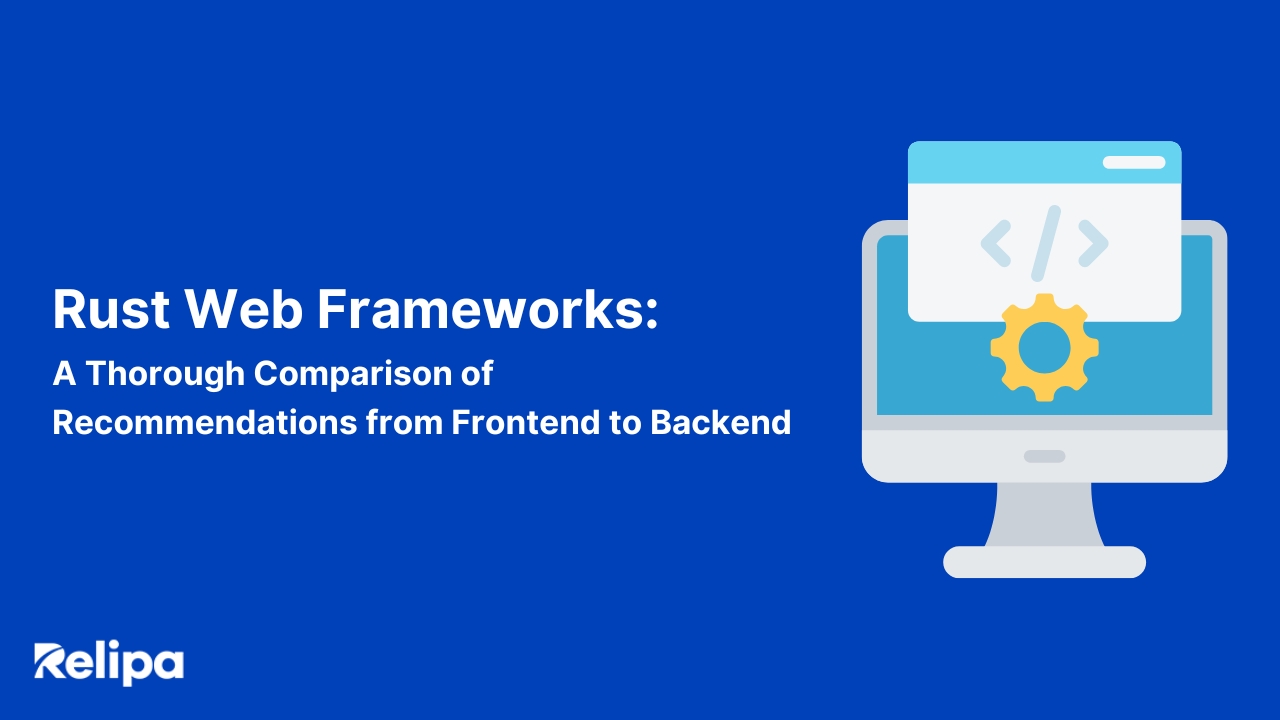10 Impressive Features And Drawbacks of GPT-4 – A Closer Look At New Evolutions In AI
The GPT-4.0 version of the AI system has enhanced its linguistic abilities but is still imperfect, and in some cases, it can be abused.
ChatGPT is a groundbreaking innovation that prompts us to reevaluate the possibilities of artificial intelligence. Its incredible ability to conduct neutral conversations, answer questions, and create coherent prose, poetry, and code sets a new standard for AI. However, while GPT-4 has promising advantages over GPT-3.5, it still has some limitations. This article will discuss ten significant advantages of GPT-4 and the drawbacks it still faces.
Read more: Maximizing ChatGPT: A Guide to Using and Exploring ChatGPT’s Use Cases
10 Advantages of GPT-4 over GPT3.5
Let’s see how the latest version of GPT, developed by OpenAI, surpasses its predecessor.
Increase the level of precision and correctness
Chris Nicholson, who is an AI expert at Page One Ventures, makes use of GPT-4 and requires the Chatbot to help him learn Spanish from scratch.
Noticeably, ChatGPT provided him with a well-organized syllabus and a wide range of tips and tricks for learning and remembering Spanish vocabulary.
However, a few pieces of advice are not straight to the point.
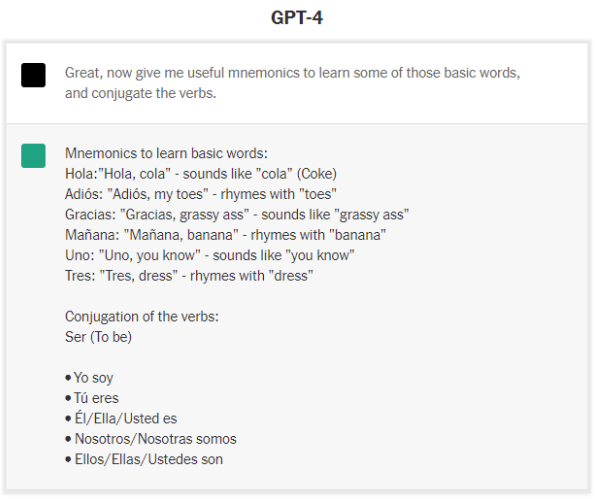
Reference: Wall Street Journal
The same prompt was required for GPT-3.5 – the antiquated GPT-4. It also provided a syllabus, but its suggestions were prone to be more general and rambling or unhelpful.
“We broke the precision barrier,” said Nicholson. “It contains more facts and they are very often correct.”
Improve Accuracy
Oren Etzioni, an artificial intelligence researcher, and professor, asked a straight question when he first tried out the new bot. “What is the relationship between Oren Etzioni and Eli Etzioni?” The bot responded correctly.
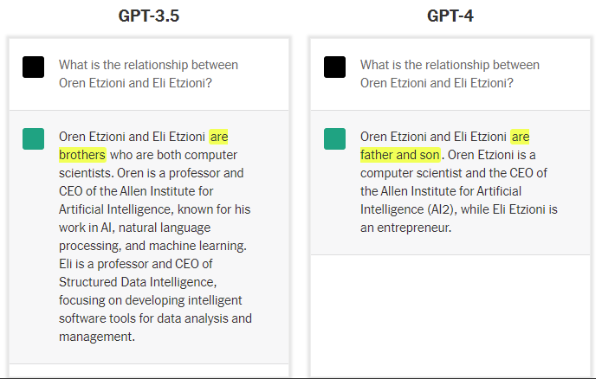
Reference: Wall Street Journal
The previous version of GPT-3.5’s answer to that question was always inaccurate. By way of explanation, it shows that the latest version of Chatbot has a wider range of knowledge, but according to the aforementioned, GPT-4 still makes mistakes.
For example, in a recent conversation, the bot stated that Oren Etzioni is a computer scientist and CEO of the Allen Institute for Artificial Intelligence (AI2), while Eli Etzioni is an entrepreneur. However, this information is outdated, as Dr. Etzioni recently stepped down as CEO of the Allen Institute. It’s important to keep in mind that AI models rely on the data they are trained on, and may not always have access to the most up-to-date information.
Update to Recognize and Analyze the Image
GPT-4 represents a major leap forward in AI technology, with new features that allow it to process not only text but also images. In a recent demonstration, OpenAI President and co-founder Greg Brockman showed how the system can provide detailed explanations of images from the Hubble Space Telescope. Additionally, GPT-4 can answer questions about images and suggest practical solutions. For example, if you provide a picture of the contents of your fridge, GPT-4 can suggest several meals that you can make with the ingredients you have on hand. These new capabilities represent a significant step towards more advanced and flexible AI systems that can handle a wide range of tasks.

Reference: Wall Street Journal
The image input function is still private to OpenAI, but a company called Be My Eyes has already used this function of GPT-4. GPT-4 is building a service that can give you a more detailed idea of images you’ve encountered on the internet or snapped in the real world.
The function of image recognition is still limited and not released to the public, but Be My Eyes has already used GPT-4. By GPT-4, Be My Eyes can alleviate obstacles and improve the lives of people who suffer from vision impairment. In retrospect, Be My Eyes needs to hire volunteers to help the patient. “In the short time we’ve had access, we have seen unparalleled performance to any image-to-text object recognition tool out there,” says Michael Buckley, CEO of Be My Eyes. “The implications for global accessibility are profound. In the not-so-distant future, the blind and low vision community will utilize these tools not only for a host of visual interpretation needs but also to have a greater degree of independence in their lives.” Suddenly, the image someone sends off, say, the contents of their fridge, GPT-4 technology not only recognizes and names what’s in there but extrapolates and analyzes what you can make with those ingredients. You could then ask it for a good recipe. The use cases are almost unlimited.
Enhance the Level of Expertise
One evening, Anil Gehi, an associate professor of medicine and cardiologist at the University of North Carolina, explained to a chatbot the medical history of a patient he had seen the previous day, including complications the patient later experienced. The description contained several medical terms that the layperson would not recognize.
When Dr. Gehi asked how the patient should have been treated, the chatbot gave the perfect answer. “That’s exactly how we treated our patients,” he said.
When he tried other scenarios, the bot returned equally impressive answers.
That knowledge is unlikely to be displayed every time the bot is used. Experts like Dr. Gehi are still needed to determine the response and carry out medical procedures. However, you can demonstrate this kind of expertise in many areas, from computer programming to accounting.
Be a Writing Assistant
When presented with an article from The New York Times, the new chatbot can provide an accurate, high-level summary of the article almost every time. Add a random number sentence to your answer and when you ask the bot if the summary is inaccurate, it points to the extra sentence.

Reference: Wall Street Journal
Dr. Etzioni said it was a remarkable skill. “High-quality summaries and high-quality comparisons require a level of understanding of the text and the ability to articulate that understanding,” he said. “It’s an advanced form of intelligence.”
Develop a Sense of Humor
Dr. Etzioni asked the new bot for “a novel joke about singer Madonna.” The reply makes him surprised. It also made him laugh. If you know Madonna’s greatest hits, you might be impressed too.
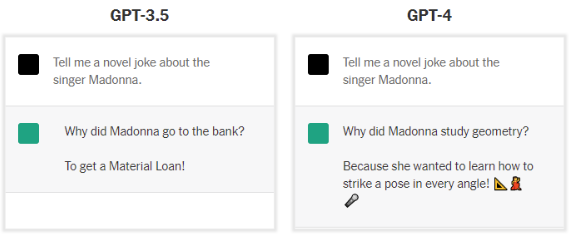
Reference: Wall Street Journal
The latest version of GTP still struggled to write anything other than the boilerplate “dad joke”. But it was more interesting than GPT-3.
Logical Thinking and Reasoning Ability
Dr. Etzioni gave the new bot a puzzle.

Reference: Wall Street Journal
The system seemed to respond appropriately. However, the answer doesn’t take into account the height of the doorway, so it may prevent tanks and cars from passing.
OpenAI CEO Sam Altman said the new bot can reason “a little bit.” But that reasoning skill falls apart in many situations. Earlier versions of ChatGPT recognized that height and width mattered, so they handled this question a bit better.
Able to Pass Standardized Tests
According to OpenAI, the latest version of GPT is capable of achieving top scores on standardized tests such as the SAT, GRE, and others, putting it in the top 10% of students. OpenAI’s own tests showed that GPT-4 scored 1,300 (out of 1,600) on the SAT and received a perfect score of 5 (out of 5) on six high school AP exams in subjects such as biology, calculus, macroeconomics, psychology, statistics, and history. Additionally, OpenAI claims that the new system can qualify students to pass the Unified Bar Exam in 41 states and territories, which was not possible with earlier versions of the technology. These results demonstrate the significant advancements made in GPT-4 and its potential to revolutionize education and testing.
Read more: Unlocking the Power of ChatGPT API (gpt-4): A Complete Guide
Drawbacks of GPT-4
Everything has two sides, and GPT-4 is not an exception. Those pitfalls will be revealed as follows.
Cannot Predict the Future
The latest version of the ChatGPT bot has shown impressive abilities to reason about past events but has struggled with making predictions about the future. During a recent conversation, Dr. Etzioni asked the bot about the key challenges facing natural language processing (NLP) in the next decade, which is a critical area of research for systems like ChatGPT. However, the bot was unable to generate entirely new ideas and seemed to rely heavily on the input it received from the conversation partner. While this limitation highlights the current boundaries of AI technology, it also underscores the potential for future advancements in NLP and related fields.
And It Still Makes Stuff up
The new bot still makes stuff up. Called “hallucination,” the problem haunts all the leading chatbots. The system doesn’t understand what’s true and what’s not, so it can generate completely wrong text.
For instance, if you ask for the address of a website describing the latest cancer research, GPT-4 could generate a non-existent Internet address.
GPT-4 has improved accuracy and precision over previous versions. Besides, it can be useful for professional industries such as medicine and computer programming. But there are still drawbacks.
Like previous GPT models, GPT-4 was trained to use public data, such as public websites, and data licensed by OpenAI. Moreover, events and knowledge beyond 2021 have not been updated. If you ask GPT-4 a question that is not included in the training data set, GPT-4 will try to answer but do not make sure this is the right answer.
Relipa’s GPT-4 Fine-tuning Service
Relipa has released a chatbot integrated with GPT-4 API. By utilizing the API of the GPT-4 model and combining your company’s data, Relipa’s chatbot can be pre-trained. So we can provide customized answers with your information.
GPT-4 is basically pre-trained across the internet and, as we saw with ChatGPT, it’s perfect for general-purpose chatbots. That said, for domain-specific tasks that require fact-based answers, GPT-4’s basic model often fails. For example, ChatGPT can only provide general information if you want to tell your customers about the features of your product.
As can be seen, the GPT-4 model answers the question well if the answer is contained within a paragraph, but if the trained dataset does not contain the answer, the base model answers anyway. They tend to do their best to do so, and often, the answers are no longer factual.
For fact-based Relipa Q&A bots, instead of “fine-tuning”, which involves updating the base model LLM weights, you can often achieve the results you want using the Embeddings API.
Use the Embeddings API to provide another document with relevant information, find sections of the document similar to the user’s query, and use this information to create dynamic prompts to answer the question.
With just a few example prompts, you can often intuitively understand the task you’re about to perform and generate a plausible completion.
At a high level, you need to do the following to create a question-answering bot.
- Prepare the training dataset
- Upload the prepared dataset to our chatbot site.
- Try our fine-tuned bot
Also, if you’re interested in tweaking or using the Embeddings API, we’re happy to announce a new service offering. GPT-4 tweak chatbot released.
At Relipa, our experienced and highly skilled engineers always keep up with new trends and are sure to master the latest technology. If you would like consultancy services to integrate GPT-4 into your business, please do not hesitate to contact us.

